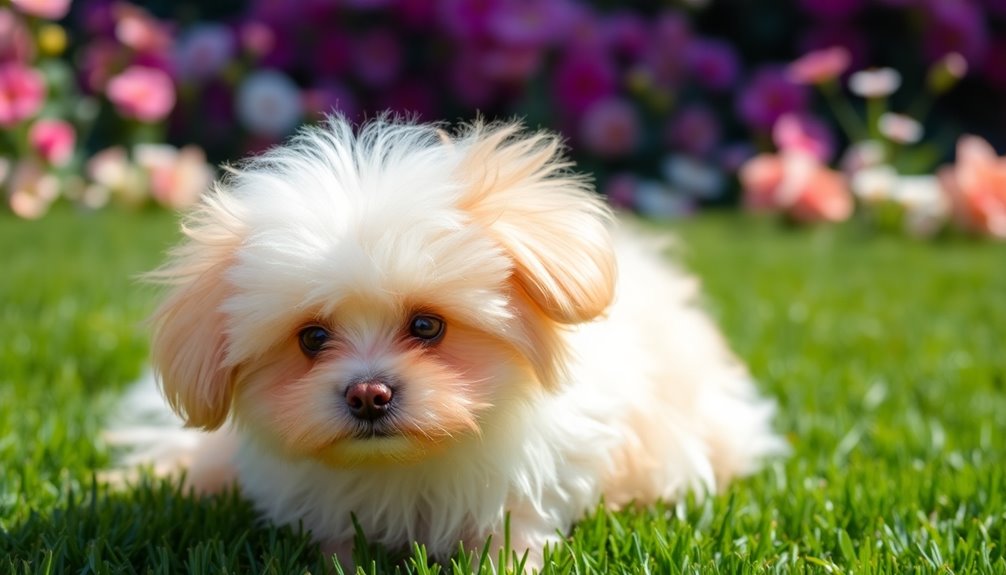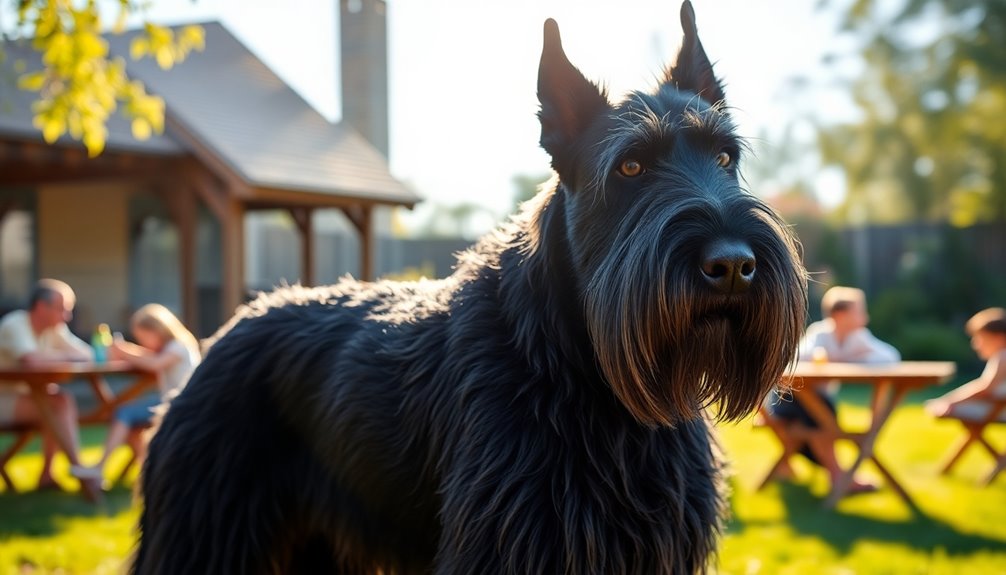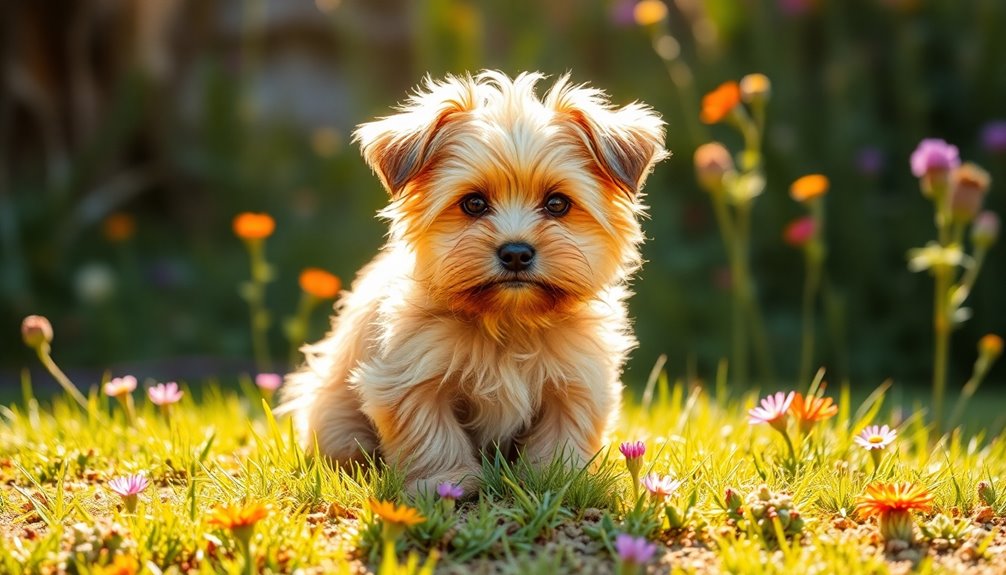The Pom-Poo, a fluffy mix of Pomeranian and Poodle, is sure to steal your heart with its playful personality and affectionate nature. Weighing between 5 to 15 pounds, these adorable pups sport soft, wavy coats that come in various colors. Their friendly demeanor makes them perfect companions for families and those living in apartments. Pom-Poos thrive on social interaction and require regular grooming to keep their coats in top shape. With a lifespan of 12 to 16 years, ensuring good health is key. Stick around, and you'll uncover more fun facts about this delightful designer breed!
Key Takeaways
- Pom-Poos are a delightful mix of Pomeranians and Poodles, known for their affectionate nature and playful spirit.
- They typically weigh between 5 to 15 pounds and stand 8 to 10 inches tall, making them small and manageable companions.
- Their coats vary from medium to long, featuring soft curls or straight fur in colors like black, white, and apricot.
- Pom-Poos are hypoallergenic, with low-shedding qualities, making them suitable for allergy sufferers.
- Regular grooming and exercise are essential to maintain their health and prevent matting in their fluffy coats.
Introduction

When you think of adorable dog breeds, the Pom-Poo often stands out for its fluffy charm and playful spirit. This delightful mix of Pomeranian and Poodle brings together the best traits of both breeds, resulting in a small dog that's not only cute but also brimming with personality.
Weighing between 5 to 15 pounds and standing 8 to 10 inches tall at the shoulder, Pom-Poos have a compact and sturdy build, making them perfect companions for families and individuals alike.
Their rounded skull and slightly tapered muzzle give them a distinctive look, complemented by large, round eyes that express curiosity and friendliness. The coat of a Pom-Poo varies significantly, featuring anything from soft curls to straight fur, and comes in an array of colors like black, white, apricot, and chocolate brown. Regular grooming is essential to maintain their coat health and prevent matting.
What's more, they often inherit the low-shedding qualities of a Poodle, making them suitable for allergy sufferers. With their friendly, affectionate demeanor, Pom-Poos are eager to bond with you and are always up for playful adventures, ensuring your life is filled with joy and companionship.
History and Origin

The Pomapoo originated in the United States during the 1980s and 1990s, specifically created by mixing Pomeranians and Poodles. This breed was designed as a companion and family pet, combining the affectionate nature of the Pomeranian with the intelligence of the Poodle. The breeding aimed to combine desirable traits from both parent breeds, resulting in a small, low-shedding dog that thrives in various living environments.
Where and when the breed originated
Originating from a blend of two distinct breeds, the Pom-Poo combines the enchanting qualities of Pomeranians and Poodles. The Pomeranian hails from the Pomerania region, now part of Poland and Germany, and was developed from ancient Spitz breeds. Initially, these dogs were larger, serving as sled-pulling and working companions.
In contrast, Poodles originated in Europe, particularly France and Germany, where they were bred for waterfowl hunting and later showcased in circuses.
The Pom-Poo emerged as a designer breed to marry the desirable traits of both parent breeds, providing hypoallergenic fur and low-shedding coats. While the exact timeframe for the creation of the Pom-Poo isn't well-documented, their popularity has surged globally, especially in urban environments. This growth can be attributed to the increased demand for crossbreeds with unique traits and appearances.
This breed's unique charm comes from the variability in behavior and appearance, influenced by the characteristics of its Pomeranian and Poodle ancestry.
Despite not being recognized by major kennel clubs, Pom-Poos have carved a niche within the designer dog community. Their lineage reflects a rich history, shaped by royal influences and geographical factors, making them a captivating addition to the world of companion dogs.
Companion and Family Pet
As a beloved companion, the Pom-Poo has gained recognition for its affectionate nature and playful spirit, making it an ideal family pet. These little bundles of joy thrive on social interaction and love to cuddle with family members.
Their playful demeanor means they enjoy engaging games, making them perfect companions for children, provided rough play is avoided.
Pom-Poos are friendly and adaptable, fitting well into various living situations, from cozy apartments to spacious homes. They develop strong bonds with their human families and prefer to be around people, which makes supervision essential when they're with young children. Setting clear boundaries can help prevent any accidental injuries during playtime.
These intelligent pups respond well to positive reinforcement training methods, making them quick learners. Early socialization is crucial for ensuring your Pom-Poo grows into a friendly and confident dog. Additionally, their moderate energy levels mean they require regular exercise and play to maintain their happiness.
While they may bark at strangers, excessive barking can be managed with training.
With moderate exercise and mental stimulation, Pom-Poos stay happy and healthy. Their low-shedding coats require regular grooming, so be prepared to invest time in their care to maintain that fluffy appearance.
Physical Characteristics
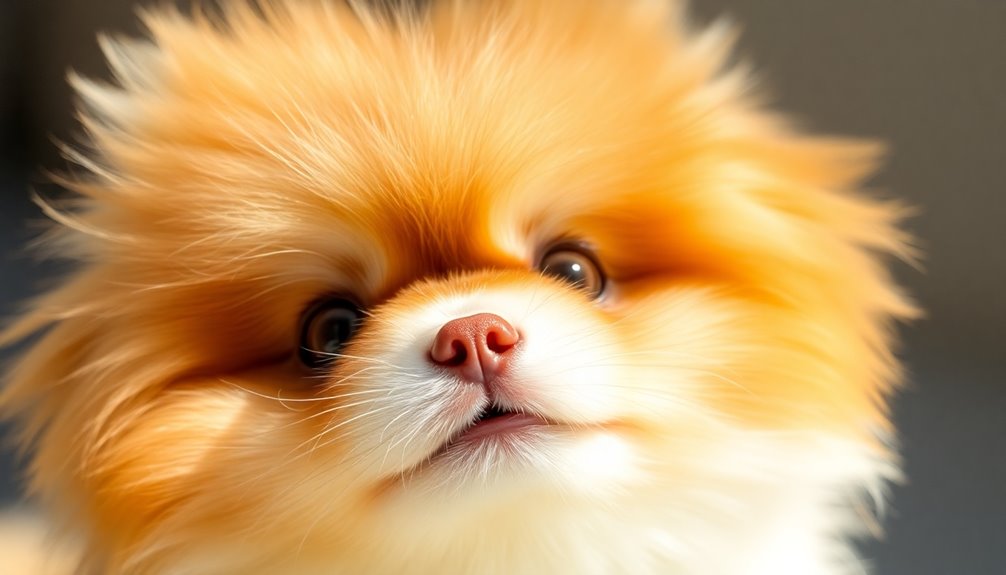
When you think about the Pom-Poo, you'll notice its compact size, typically standing between 8 to 10 inches tall and weighing between 5 to 15 pounds.
Their coat is often medium to long, ranging from curly to wavy, and it's known for being hypoallergenic, making it a great option for allergy sufferers. The color variations of the Pom-Poo can be influenced by its parent breeds, which may result in a delightful mix of hues.
With its adorable teddy bear face and fluffy fur, this mix truly captures hearts.
Size, weight, and coat details
The Pom-Poo's compact frame and fluffy coat make it a delightful addition to any home. Standing between 8 to 10 inches tall, these adorable dogs can sometimes reach up to 12 inches, thanks to the influence of their Pomeranian and Poodle parents.
Their well-proportioned bodies keep them firmly in the small dog category, making them perfect for various living situations. Additionally, their unique genetic traits from both parent breeds contribute to their charming personality.
When it comes to weight, Pom-Poos typically range from 5 to 15 pounds, with no significant difference between males and females. Their size and weight make them easy to manage, whether you live in an apartment or a larger space.
Another appealing aspect of the Pom-Poo is its coat. You can find them in an array of colors, including black, white, cream, apricot, brown, and sable, often showcasing party colors that blend multiple shades.
The coat usually varies from medium to long, and while it's soft and fluffy, it may inherit traits from either parent—be it the Pomeranian's softness or the Poodle's curliness. Regular brushing will help maintain that lovely appearance and prevent matting.
Curly, Hypoallergenic Fur Texture
Pom-Poos are known for their unique fur textures, which can vary significantly due to their mixed heritage. You might encounter curly, wavy, or straight coats, each with its own grooming needs.
If your Pom-Poo has a curly coat, expect Poodle-like curls that require frequent brushing to prevent matting. Wavy coats blend features from both the Pomeranian and Poodle, needing regular brushing two to three times a week and professional grooming every six to eight weeks. Straight coats, resembling the Pomeranian side, demand less upkeep, with trims every eight to twelve weeks.
One of the most appealing aspects of Pom-Poos is their hypoallergenic qualities. Often inheriting the Poodle's low-shedding coat, they're a suitable choice for allergy sufferers. However, the effectiveness of their hypoallergenic properties can vary based on genetics, so regular grooming is essential. Additionally, genetics can significantly influence a Pom-Poo's coat texture and fluffiness, making it essential to understand their lineage.
To maintain a healthy coat, you should schedule professional grooming for curly coats every four to six weeks and bathe your Pom-Poo every four to six weeks as well.
Temperament and Personality

When it comes to temperament, the Pom-Poo shines with its playful and social demeanor, making it a great companion for families, individuals, and other pets.
You'll find this mix loves to engage with everyone around them, forming strong bonds while enjoying playful interactions. Their friendly nature ensures they're always ready to join in on the fun, whether it's cuddling on the couch or playing in the yard. Additionally, their affectionate nature allows them to thrive on human companionship, making them eager participants in daily activities.
Playful and Social Demeanor
With their playful spirit and affectionate nature, Pom-Poos make delightful companions for families and individuals alike. This poodle mix inherits a lively personality from both Pomeranians and Poodles, ensuring they thrive on fun and interactive playtime.
You'll find that they enjoy games, puzzles, and squeaky toys, making them perfect playmates for kids. While they require regular play sessions and short walks to stay happy, they don't need extensive exercise, making them suitable for various living situations. Low exercise requirements allow them to adapt well to different lifestyles.
Socially, Pom-Poos form strong bonds with their owners and crave human companionship. Although they might be a little wary of strangers initially, proper socialization helps them warm up.
You'll notice their friendly demeanor as they generally get along well with others, including other pets. To build their confidence, early socialization is essential, as they tend to follow you around the house, eager for your attention and affection.
Their intelligence and quick learning ability mean they respond well to positive reinforcement training, picking up commands with ease.
This combination of playfulness and sociability makes Pom-Poos truly charming companions that light up any home.
Suitability for families, individuals, or other pets
These affectionate and playful dogs adapt well to various living situations, making them suitable companions for families, individuals, and even other pets. They thrive in homes with respectful children, but you'll need to supervise interactions, especially with small kids who might play too rough.
Early socialization is vital for a smooth family integration, as these dogs bond closely with their loved ones and seek constant companionship. Pomapoos typically reach their mature size by 12 months of age, which allows for a stable size that fits well in many living environments.
While Pom-Poos can fit into families with older children, they're not ideal for households with very young kids due to their delicate nature. They do well in apartments or larger homes, as long as they receive plenty of love and attention.
Their lifestyle flexibility means they adapt easily, whether you're busy or more laid-back.
For individuals, Pom-Poos offer loving companionship, thriving in environments where someone is often around. They do best with regular interaction to avoid anxiety.
Their small size and moderate exercise needs make them perfect for apartment living. With proper grooming and training, they become well-behaved companions, providing emotional support while warming up quickly to new people.
Health and Lifespan
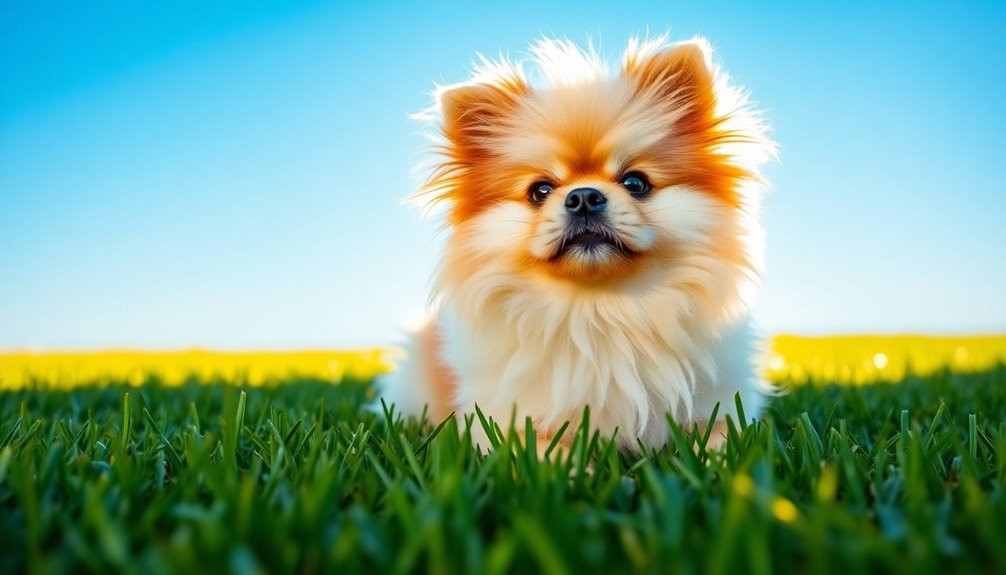
When it comes to your Pom-Poo's health and lifespan, you'll want to be aware of common issues like cataracts and dental problems. Typically, these adorable pups live around 12 to 15 years, but with proper care, some can exceed that. Regular veterinary check-ups are vital for maintaining overall health and catching potential issues early.
Typical lifespan of the breed
The typical lifespan of a Pom-Poo ranges from 12 to 15 years, making them a relatively long-lived breed among small dogs. With proper care, some can even live up to 16 years, thanks in part to the hybrid vigor inherited from their Poodle parent. This mix generally enjoys an average lifespan comparable to other small breeds, benefiting from the genetic diversity of crossbreeding. Additionally, Doodles generally have longer lifespans than most pure breeds due to their healthier genetics.
Several factors significantly influence your Pom-Poo's lifespan. Nutrition is crucial; a balanced diet rich in protein, healthy fats, and essential vitamins can enhance longevity. Regular exercise helps maintain their overall health, so ensure they get plenty of physical activity. Moreover, maintaining a healthy weight can significantly reduce the risk of common health issues that may affect their lifespan.
The breeding history and health of their parents also play a critical role, so be mindful of the pup's lineage. Additionally, the environment where you raise your Pom-Poo matters. Offering stable and loving conditions will positively impact their well-being.
You might notice that smaller versions of the breed could have slightly shorter lifespans due to their fragility. Overall, with attentive care, your Pom-Poo can thrive and enjoy a long, happy life by your side.
Common health concerns or genetic predispositions
Pom-Poos, like many mixed breeds, can inherit a variety of health concerns from their parent breeds, the Pomeranian and the Poodle. From the Pomeranian side, you might encounter issues like canine epilepsy, which involves seizures and requires long-term medication.
Patellar luxation is another concern, where the knee joint can painfully slide in and out of place. Degenerative Myelopathy and hereditary vitamin D-resistant rickets also pose risks, though they're less common.
On the Poodle side, skin allergies and food intolerances are prevalent, along with Addison's and Cushing's diseases, both hormone-based conditions. Regular vet checks can help in early detection and management of these conditions.
Von Willebrand's disease, a blood disorder, and progressive retinal atrophy, which affects vision, are additional risks.
Pom-Poos can also face common health issues, such as dental problems, weight gain, and cataracts.
Tracheal collapse can occur at any age, and you may notice epilepsy showing up in puppies.
Moreover, luxating patellas, skin problems, and eye diseases like cataracts can arise.
Hypoglycemia is more common in toy breeds, particularly in the early months of life.
Lastly, keep an eye out for Legg-Calve-Perthes disease affecting the hips.
Tips for maintaining health and wellness
Maintaining your Pom-Poo's health and wellness requires a proactive approach that encompasses proper grooming, nutrition, exercise, and regular vet visits.
Start with grooming; bathe your Pom-Poo every three weeks to keep their skin healthy and coat shiny. Brush their fur every one to three days to prevent matting and remove dead hair. Don't forget to use grooming wipes for quick clean-ups and facial wipes to keep their face clean. Regular brushing is essential for distributing body oils and promoting healthy fur. Additionally, regular grooming can help prevent chin mites, which are common in many breeds.
When it comes to nutrition, choose all-natural, high-quality food and avoid harmful ingredients. Incorporate healthy snacks like raw carrots and blueberries while steering clear of commercial treats laden with chemicals. Always ensure your Pom-Poo has fresh water and consider home-cooked meals for added nutrition.
Regular exercise is key. Aim for short walks and play sessions, but be cautious not to overexert puppies. Activities like fetch are great for keeping them active.
Lastly, schedule regular vet visits for health checks, maintain a pet-friendly environment, and remember to clean their teeth to support oral health.
Care Requirements
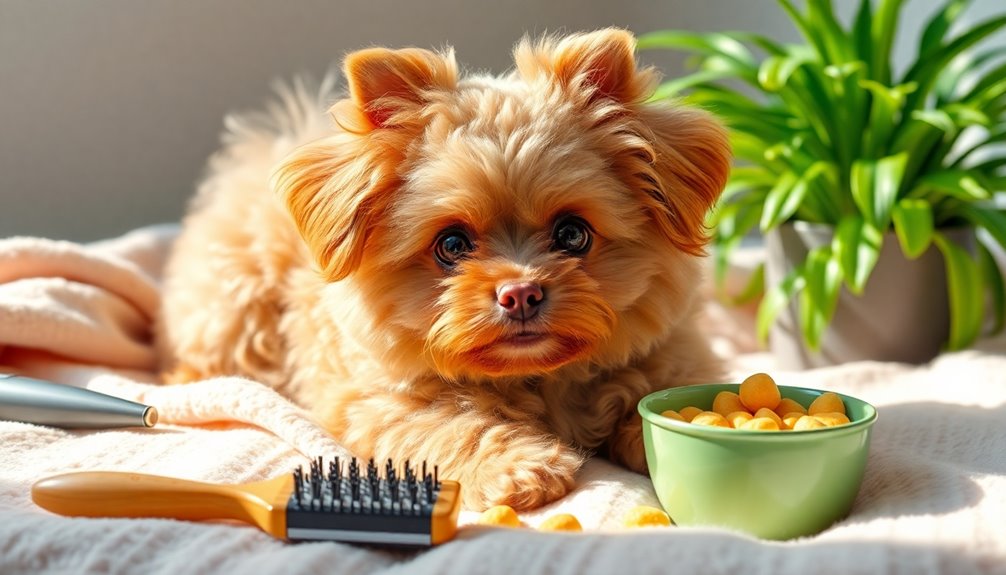
Caring for your Pom-Poo involves regular brushing to keep their coat healthy and tangle-free, with the frequency depending on their coat type. Daily brushing is recommended to prevent matting and remove dead hair, with a minimum of 3-4 times a week if daily is not feasible. You'll also need to ensure they get enough exercise through daily walks and playtime to keep their energy levels balanced. Don't forget about nutrition; feeding them the right amounts and types of food is crucial for their overall health. Additionally, regular bathing is necessary for hygiene, ideally every 4-8 weeks, based on lifestyle and coat type, and knots should be brushed out before washing to maintain coat health.
Regular Brushing Required
To keep your Pom-Poo looking its best, regular brushing is essential. Aim to brush your furry friend daily to prevent matting and remove loose hair. If your Pom-Poo has a straighter coat, brushing 3-4 times a week is sufficient, but during heavy shedding seasons, daily grooming becomes a must.
For effective brushing, invest in a high-quality slicker or pin brush for general grooming. A sturdy comb is great for tackling stubborn knots, and a non-rotating rake can help during shedding periods. When brushing, work from the bottom up to ensure you reach both the undercoat and outer coat. Be gentle around sensitive areas like the belly, tail, and behind the ears.
Consider using a conditioning spray to mist your Pom-Poo lightly, which can prevent hair breakage. Regular brushing not only keeps the coat soft and fluffy but also helps distribute natural oils, enhancing overall cleanliness and health. By maintaining a consistent brushing routine, you'll prevent skin irritation, reduce shedding, and keep your Pom-Poo looking adorable and vibrant. Additionally, regular grooming promotes good hygiene, which is essential for your Pom-Poo's overall health and well-being.
Exercise requirements and energy levels
Regular grooming not only keeps your Pom-Poo's coat in top shape but also sets the stage for understanding their exercise needs and energy levels.
These little bundles of joy don't require hours of intense activity. Instead, a couple of short walks each day will usually suffice to meet their exercise needs. Interactive play sessions, like fetch or hide and seek, are essential for keeping them entertained and mentally stimulated.
Pomapoos thrive on mental challenges, so consider incorporating puzzle toys or agility training into their routine. While most Pomapoos are energetic, some may have a seemingly endless supply of energy, requiring a bit more activity. It's important to remember that daily exercise is crucial for their overall health and helps prevent obesity. Including durable toys in their playtime can further enhance their engagement and enjoyment.
Short walks around the neighborhood or yard are perfect, but be sure to avoid over-exerting them due to their small size.
Living in an apartment? No problem! Pomapoos adapt well to smaller spaces and often keep themselves busy by playing games and following you around.
Just remember to maintain consistent daily routines to manage their energy levels effectively. Safety is key, so always use a leash during walks and be cautious of larger dogs that might pose a risk.
Feeding tips and diet recommendations
A well-balanced diet is essential for keeping your Pom-Poo healthy and vibrant. Start with high-quality animal-based proteins like beef, chicken, or fish as the first ingredient in their food. This ensures they get vital amino acids for muscle development and overall vitality. A raw diet can lead to better digestion, reduced waste, and improved dental health, making it a great option for your Pom-Poo.
Healthy fats, including Omega-3 and Omega-6 fatty acids from fish oil or flaxseed oil, support brain function and maintain a shiny coat. Provide essential vitamins and minerals to strengthen their bones and promote skin health. Add plain yogurt or dried eggshells for calcium, and consider incorporating apple cider vinegar for extra benefits.
For feeding schedules, give puppies 3-4 small meals daily, transitioning to 2-3 meals as they grow. Adults should have 2 meals per day, with portions adjusted according to age and activity level.
Senior Pomapoos benefit from a lower-calorie dog food formula. Keep in mind that treats should only make up 10% of their daily caloric intake to prevent weight gain, as Pom-Poos can easily become overweight.
Training and Socialization
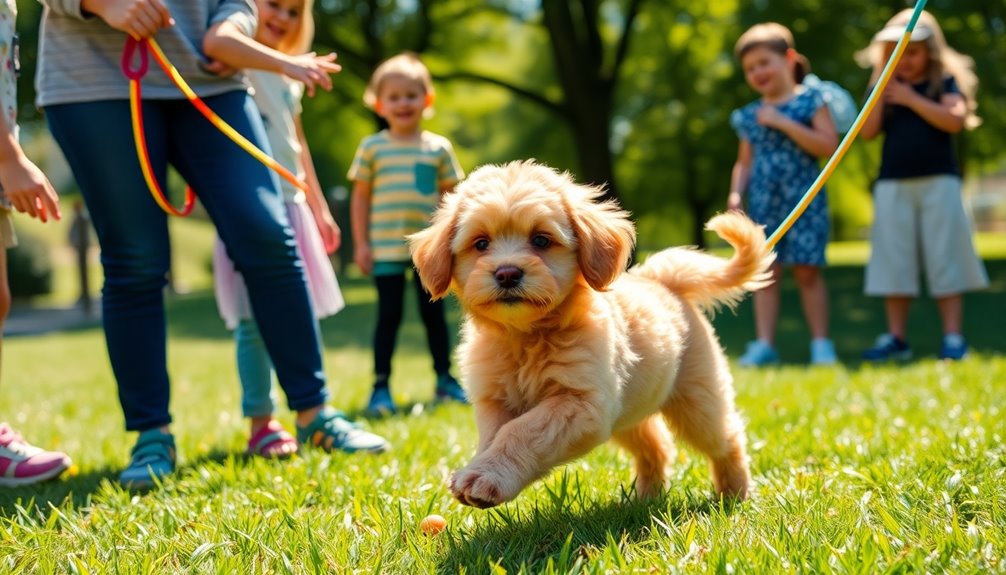
Training your Pom-Poo is essential, as they're highly intelligent and responsive, making them eager to learn. Establishing a routine with frequent potty breaks can help them feel secure and reduce any anxiety they may have. Gradually exposing them to new environments helps build their confidence and adaptability. Additionally, incorporating structured playtime activities can enhance their socialization skills and promote positive interactions with other pets and people. Keep in mind that these pups can experience separation anxiety, so fostering their socialization skills is crucial for their well-being.
Highly Intelligent and Responsive
Pom-Poo owners quickly discover that these fluffy companions aren't just adorable but also highly intelligent and responsive. You'll find that training your Pom-Poo is a rewarding experience, as they quickly grasp commands and instructions. To enhance their training experience, consider implementing risk management strategies that can help you navigate any challenges during the process.
While they may not match the intelligence of breeds like German Shepherds, their ability to learn complex tasks and solve puzzles is impressive. To maximize their potential, stick with consistent training routines. Confusion arises when commands vary, so be clear and consistent.
Positive reinforcement works wonders—using treats, praise, and affection encourages your Pom-Poo to engage and learn. Avoid harsh corrections; they can lead to fear and anxiety, hindering your training efforts. Additionally, consistent supervision during training is essential to reinforce desired potty behavior and prevent accidents.
Short, fun training sessions keep your Pom-Poo engaged while also providing essential mental stimulation. Incorporate puzzle toys, obedience challenges, and interactive games to prevent boredom and unwanted behaviors. Activities like hide-and-seek or scent-tracking not only enhance their skills but also strengthen your bond.
Early socialization is vital, too, as it lays the groundwork for good behavior. By nurturing their intelligence and providing stimulating activities, you'll ensure your Pom-Poo remains a happy and well-adjusted companion.
Gradual Exposure to New Environments
As you introduce your Pom-Poo to new environments, it's important to take a gradual approach that helps them feel secure and confident. Start in familiar places like your home or backyard, making small changes such as adding new toys or blankets. Soothing music can create a calming atmosphere, so consider playing it during these transitions. Always reward calm behavior with treats and praise, reinforcing their positive experiences.
When exploring new areas, choose quiet spots first, like less crowded sections of parks or beaches. Watch your Pom-Poo's reactions closely and adjust your pace according to their comfort level. Bring along familiar toys or games to engage them in these new surroundings. Keep initial sessions short and rewarding, retreating to quieter spots if your dog shows signs of discomfort. Additionally, ensure your Pom-Poo has had their critical vaccinations before venturing out to new places, as this is vital for their health and safety. This is particularly important as home security systems can help protect your property while you are out exploring.
Incorporating various sounds and textures helps build confidence. Start with low-volume recordings of everyday noises and gradually increase exposure. Use positive reinforcement to encourage curiosity and social engagement, creating positive associations with new experiences.
Separation Anxiety Issues
Building your Pom-Poo's confidence in new environments is just one part of ensuring their overall well-being. Separation anxiety can significantly impact your furry friend, so recognizing the causes is essential. Genetic predispositions from their Poodle and Pomeranian lineage may increase anxiety. Early life experiences, like traumatic separations or inconsistent training, can also exacerbate the issue.
You might notice signs such as excessive barking, destructive behavior, or even potty accidents when you leave. To mitigate these symptoms, implement gradual desensitization. Start by leaving your Pom-Poo alone for short periods, gradually increasing the time. It is important to remember that certain breeds are particularly sensitive to feelings of abandonment, which can increase the likelihood of anxiety. Additionally, offering your Pom-Poo a protein-rich treat during your departures can help create positive associations with being alone.
Create a safe space filled with their favorite toys and your scent to provide comfort. Regular exercise and mental stimulation are key, so engage them with puzzle toys or interactive games.
Establishing a consistent routine helps minimize anxiety triggers. If necessary, don't hesitate to seek professional advice from a dog trainer or behaviorist. In severe cases, consult your veterinarian about medication options.
Lastly, reward your Pom-Poo for calm behavior during absences to build their confidence and independence. This proactive approach will help your Pom-Poo thrive.
Ideal Living Environment
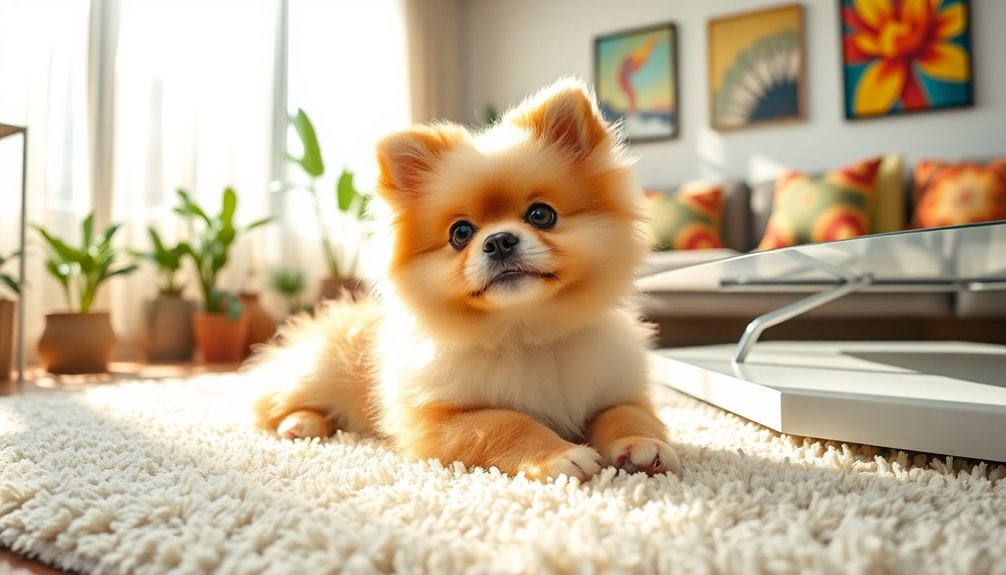
If you're considering a Pom-Poo, an apartment near parks is perfect for their small size and need for regular walks. They thrive in warm, temperate climates, so make sure your living environment maintains a comfortable temperature year-round. With the right setup, these adorable pups will feel right at home. Additionally, since Pomapoos have a medium activity level, daily exercise and mental stimulation are essential for their happiness and well-being. Ensuring a nurturing environment can help promote emotional intelligence, which is vital for fostering a strong bond between you and your Pom-Poo.
Apartment With Nearby Parks
Living in an apartment with nearby parks creates an ideal environment for both you and your Pom-Poo. Imagine waking up in a luxury apartment with high-end features like 9- and 10-foot ceilings and private balconies.
You'll enjoy resort-like living with amenities such as an on-site café and beautiful outdoor courtyards. Additionally, the community includes studio, 1-bedroom, and 2-bedroom units designed to accommodate various lifestyles. With campgrounds just a stone's throw away, your furry friend will have plenty of space to run and play. These parks offer lush landscapes, walking paths, and even community garden plots, allowing you both to explore and enjoy nature.
Scenic picnic areas and benches are perfect for relaxing while your Pom-Poo sniffs around and makes new friends.
Your apartment's pet-friendly community ensures that your Pom-Poo feels right at home. You'll have access to private gardens and courtyards where they can stretch their legs.
Plus, the location is minutes from Manhattan, making it easy to enjoy the hustle and bustle of the city whenever you desire.
With convenient access to public transportation and local amenities, you can create a fulfilling lifestyle that benefits both you and your adorable companion.
Warm, Temperate Climates Preferred
When it comes to your Pom-Poo's ideal living environment, warm, temperate climates are a must for their comfort and well-being. These adorable pups don't fare well in extreme weather. Their small size makes them particularly sensitive to both extreme heat and cold, which can lead to health issues. To keep your Pom-Poo healthy, it's best to avoid harsh weather conditions and provide a moderate climate.
While they prefer temperate climates, Pom-Poos don't need a lot of space or extensive exercise. Short walks and interactive play sessions are usually enough to meet their activity needs. They can thrive in both small and larger living spaces, as long as they receive regular activity. A fenced-in yard is a plus, but you should supervise them, given their tiny stature.
Regular veterinary check-ups are essential to monitor your Pom-Poo's health, especially if they spend more time outdoors in temperate climates. Additionally, preventative treatments for parasites are crucial. Shih-Poos, like Pom-Poos, are also known for being friendly companions, making them ideal pets for families and individuals alike.
Keeping them indoors during extreme weather will help maintain their health and ensure they lead a balanced lifestyle filled with exercise and social interaction.
Poodle Ancestry Enhances Intelligence

When you think about the Pom-Poo, remember that its Poodle ancestry brings a wealth of intelligence to the mix. This breed's ability to learn quickly and adapt makes it a star in viral videos, showcasing its charm and skills. Additionally, Poodles excel in obedient intelligence, which contributes significantly to the Pom-Poo's quick learning abilities. Plus, with a variety of coat colors available, each Pom-Poo has its own unique flair that adds to its appeal.
Variety of Coat Colors Available
The Pom-Poo boasts a stunning variety of coat colors, making each one a unique bundle of joy. You'll find shades ranging from brown, black, and white to striking combinations that showcase the charm of both Poodles and Pomeranians.
With their Pomeranian ancestry, Pom-Poos can inherit a dense, double coat, while the Poodle influence often results in low-shedding, hypoallergenic fur. This breed's high intelligence allows them to learn grooming routines quickly, making maintenance a breeze for their owners.
The unpredictability of their appearance includes solid colors, parti-color patterns, and combinations like black and tan or chocolate and tan. You might even come across rarer colors such as beaver, lavender, or blue brindle.
Sable variations, such as cream sable or red sable, add to the visual allure of these adorable pups.
The Poodle's curly or wavy hair texture introduces even more variety, resulting in straight, fuzzy, curly, or wavy coats. This mix not only enhances their looks but also makes grooming easier, thanks to their intelligence.
Whether you prefer a solid color or a dazzling pattern, the Pom-Poo's coat colors are sure to captivate and delight any dog lover.
Pom-Poo Stars in Viral Videos
Captivating audiences with their charm and intelligence, Pom-Poos have become stars in viral videos across social media platforms. Their Poodle ancestry endows them with impressive smarts, ranking as the second brightest dog breed. This intelligence translates into extraordinary trainability, allowing them to learn commands about five times faster than many other breeds.
You'll often see Pom-Poos showcasing their skills in videos, recalling commands with a remarkable 95% success rate. Their sharp awareness makes them excellent watchdogs, despite their small size, often alerting families to any unusual activity. Additionally, their mixed lineage contributes to their unique characteristics, making them sought-after family pets. Moreover, their high level of intelligence is akin to the benefits derived from educational toys, which stimulate cognitive growth in young children.
However, early training and socialization are crucial to manage their occasional stubbornness. Positive reinforcement works wonders, making training sessions enjoyable and effective.
Pom-Poos also exhibit endearing behavioral traits, forming close bonds with family members while remaining wary of strangers. Their sociable nature shines through in viral clips, where they engage playfully with their loved ones.
They thrive in households where they aren't left alone for long periods, making them perfect companions for families, especially those with older children. So, it's no surprise that Pom-Poos are becoming beloved stars in homes and on screens alike!
Active Lifestyle Compatibility?

If you lead an active lifestyle, a Pom-Poo could be a perfect companion for you.
They thrive on regular exercise and enjoy interactive play, making them great for outdoor adventures and daily walks. Additionally, Pomapoos are generally active dogs that require daily exercise to support their physical and mental well-being, so you can expect consistent engagement in your daily routine. Just remember, their grooming needs require attention, so be prepared to keep them looking their best while you stay active together.
Great for Active Individuals
For those leading an active lifestyle, the Pom-Poo proves to be a delightful companion. This adorable poodle mix doesn't require hours of intense activity, making it perfect for moderate activity levels. Daily walks and playtime are essential, and you'll find that short walks and interactive play sessions keep your Pom-Poo happy and healthy.
If you're particularly energetic, consider adding puzzle toys or agility training to keep your furry friend engaged.
Living in an apartment or a larger home? No problem! The Pom-Poo adapts well to various living situations and doesn't need much space to exercise. Just remember to provide regular mental stimulation alongside physical activity, as this is crucial for their overall well-being.
Despite their adaptability, be mindful of extreme weather conditions due to their small size. These pups thrive in environments filled with love and attention, making them great companions for families with children, as long as interactions are gentle.
With daily short walks and play, you'll enjoy a strong bond with your Pom-Poo while ensuring they lead an active and fulfilling life.
Grooming Needs and Maintenance
Maintaining your Pom-Poo's grooming needs is just as important as keeping up with their activity levels. Regular grooming not only keeps your furry friend looking adorable but also promotes their overall health. To maintain their health, it's essential to recognize their coat characteristics, as this will help you choose the right grooming practices for your Pom-Poo's non-shedding nature.
You'll need a high-quality slicker or pin brush for daily brushing to prevent matting, especially if your Pom-Poo has a curly coat. For tangles in delicate areas like the face and ears, a sturdy comb comes in handy.
You should trim their hair every 4-8 weeks, depending on their coat type. Bathing every 4-6 weeks with dog-specific shampoo and conditioner will help maintain a healthy coat.
Don't forget about nail trimming, which should be done weekly or bi-weekly to avoid discomfort. Ear cleaning is crucial too; check them weekly and clean them after baths or swims.
Regularly brushing their teeth with vet-approved toothpaste can prevent dental problems. If you're unsure about grooming, consider professional help—every 4-6 weeks for curly coats, or every 6-12 weeks for wavy and straight coats.
With proper grooming, your Pom-Poo will thrive in both activity and health!
Frequently Asked Questions
What Is the Best Diet for a Pom-Poo?
To ensure your dog thrives, focus on a balanced diet rich in high-quality proteins like chicken or beef.
Incorporate healthy fats for energy and coat health, plus complex carbohydrates from sweet potatoes or brown rice.
Puppies need multiple meals daily, while adults do well with two.
Treats should be limited to 10% of their daily intake.
Always introduce new foods gradually and consult a vet for tailored dietary advice to meet their specific needs.
Are Pom-Poos Hypoallergenic?
While Pomapoos may inherit some hypoallergenic traits from their Poodle parent, they aren't completely hypoallergenic.
Their low-shedding coats can reduce dander, which is a common allergen, but you might still experience allergic reactions. Reactions vary from person to person, so it's best to spend time with a Pomapoo before deciding.
Regular grooming can help minimize allergens, but remember, no dog is entirely free of dander or allergens.
How Much Do Pom-Poos Typically Weigh?
When you're considering a small dog, weight can vary significantly.
Typically, these dogs weigh between 5 and 15 pounds, influenced by their Pomeranian and Poodle ancestry. Some might be on the smaller side, resembling a Pomeranian more closely, while others can be slightly larger due to Poodle traits.
Do Pom-Poos Shed a Lot?
When it comes to shedding, it really depends on the coat type your dog inherits.
If your dog has a straight coat, you might notice more shedding, which means you'll need to brush daily or every other day.
On the other hand, if your dog has a curly coat, shedding will be minimal, requiring less frequent brushing.
Seasonal changes could also lead to some extra shedding, so keep an eye on that!
Can Pom-Poos Be Left Alone for Long Periods?
If you're considering leaving a Pomapoo alone for long periods, it's best to limit it to 6-8 hours.
These dogs thrive on social interaction, and too much time alone can lead to stress and anxiety.
For younger pups, aim for just 1-2 hours.
Training and socialization can help them adapt better, but remember to provide a safe environment with toys and routines to ease their loneliness when you're away.
Conclusion
In conclusion, the pom-poo is a delightful blend of charm and intelligence, making it an excellent companion for various lifestyles. With their adorable looks and vibrant personality, you'll find joy in every moment spent with these fluffy poodle mixes. Remember to provide proper training and socialization to help your pom-poo thrive. Whether you're an active individual or someone who enjoys a cozy night in, this lovable breed is sure to fill your life with happiness.

